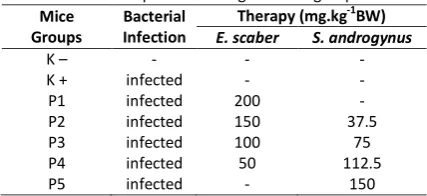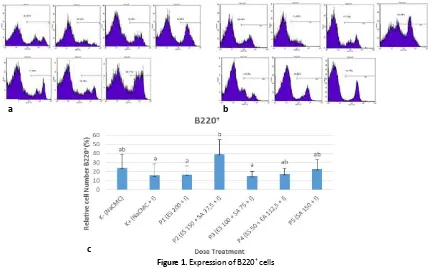Bone Marrow Cells Lymphocyte Activity of Pregnant Mice with Therapy of
E. scaber
and
S. androgynus
Post Infection
Salmonella typhimurium
Muhammad Basyaruddin
1,2*, Moh. Sasmito Djati
2*, Sri Rahayu
21
Master Program of Biology, Faculty of Mathematics and Natural Sciences, University of Brawijaya, Malang, Indonesia
2
Laboratory of Animal Physiology, Department of Biology, Faculty of Mathematics and Natural Sciences, University of Brawijaya, Malang, Indonesia
Abstract
Pregnancy can cause immune system changes. It is characterized by a decrease in the activity of immunocompetent cells. The use of antibiotics was intended to combat pathogenic microorganisms, but antibiotics have negative effects on pregnant women. The use of antibiotics can be replaced with extracts of Elephantopus scaber and Sauropus androgynus because both plants have chemical compounds that act as immunomodulators. This study was aimed to determine the activity of lymphocytes B220+, TER119+, and GR-1+ on bone marrow pregnant mice given the combination of extracts of Elephantopus scaber and Sauropus androgynus after infected with Salmonella typhimurium.
This research uses seven treatment groups name: (K-) 0.05% NaCMC without bacterial infection; (K+) 0.05% NaCMC infected by bacteria; (P1) E. scaber 200 mg.kg-1BW infected by bacteria; (P2) E. scaber 150 mg.kg-1BW and S. androgynus
37.5 mg.kg-1BW infected by bacteria; (P3) E. scaber 100 mg.kg-1BW and S. androgynus 75 mg.kg-1BW infected by bacteria; (P4) E. scaber 50 mg.kg-1BW and S. androgynus 112.5 mg.kg-1BW infected by bacteria; and (P5) S. androgynus
150 mg.kg-1BW infected bacteria. The initial dose of E. scaber and S. androgynus was 50 mg.kg-1. Each treatment has three repetitions, surgery performed on day 12th and 18th. Lymphocyte cells isolated from bone marrow, the obtained results were analyzed by flowcytometry and statistical analysis using SPSS 16.0 one-way ANOVA, Tukey test and path. Based on the results from ANOVA tables, the formulations on mice that can restore their normal conditions with B220+ cells is E. scaber 150 mg.kg-1BW and S. androgynus 37.5 mg.kg-1BW, TER119+ cells is S. androgynus 150 mg.kg-1BW, while the GR-1+ cells affected by the surgery. Those three dose formulations can be used to obtain the optimum value which can increase the number of lymphocytes and not harmful to the developing fetus.
Keywords:Bone marrow, Elephantopus scaber, Lymphocyte, Pregnant mice, Sauropus androgynus
INTRODUCTION
Pregnancy in women will affect the physiolo-gical condition of the body. In the state, pregnant women will experience changes in their immune system, which is intended to facilitate embryo implantation, placental development, fetal tole-rance initiated, as well as the defense of the maternal immune system [1]. Changes in the pregnant woman's immune system will lower the immune system [2], thus with such a situation pregnant women susceptible to disease [3].
One change that affects the immune system
of pregnant women is Salmonella [4]. Previous
study analyzed 200 blood samples and found that 129 women have positive samples of typhoid fever [5]. The ability of the bacteria causing typhoid fever because it has a Vi antigen capable of reducing the expenditure of IL-8, which has the role of neutrophils inducers [6].
Correspondence author:
Muhammad Basyaruddin
Email : elbasyary@gmail.com
Address : Laboratory of Animal Physiology, Department of Biology, University of Brawijaya, Jl. Veteran Malang, 65145
Intracelular facultative bacteria live and reproduce in varies of cell types, including macro-phage which leads prominent in immunity. Celullar immunity mechanism is the most appro-priate mechanism to do elimination, where
other pathogens. Influence exerted by
pathogenic microorganisms will lead to symp-toms of toxicity. Delays in handling would result in perforation, periontitis, loss of consciousness and death [2]. The infection will also cause damage to erythrocytes and through lysis [8]. Infection will result in inflammatory cells and affect the polymerase and differentiation of B cells thus activity of erythrocyte disturbed [9].
The synthetic compounds administered to pregnant women to prevent immune
defici-encies. However, this compound causes
alternatives with systemic effects found herbal medicine [10].
E. scaber and S. androgynus has been widely studied as a natural immunomodulator [11,12], but it is not known how the effect when both
This experimental research was conducted by using seven experimental groups, i.e. two control groups and five treatment groups. Surgery performed on the 12th and 18th after the animal was assumed to be pregnant by comparing the results of observation on treatment and control, as well as between the treatment groups.
Total of 42 Balb/C mice were divided into seven treatment groups, each group consisted of three replications. Mice got the same standard treatment of eat and drink ad libitum. An object of experimentation is pregnant female mice strains balb/c obtained from PT. Galaxy science
Jember. Bacteria S. typhimurium was injected
intraperitoneal. We used strains 444-D from the collection of the Laboratory of Microbiology, Faculty of Medicine, University of Brawijaya.
Extract Preparation
Simplicia obtained from medika materia, Batu. The extract was made by maceration in 70% ethanol solution of 1:3 for 1x24 hours with occasional stirring. After 24 hours, the results were filtered using a Buchner funnel to get the plsntd extract, then evaporated at evaporator tube rotating speed of 200rpm at a temperature
of 40oC waterbath. The condensed filtrate was
weighed and prepared by dissolving treatment with 0.05% NaCMC and administered orally to Administration of extracts combination was
continued until surgery on the 12th and 18th day. Extracts were given by sonde daily before meal.
Table 1. Experiment design of mice groups
Mice
Note: Control (K) were given 0.05% NaCMC
Isolation of Lymphocytes
Isolated bone marrow flushed with PBS using a syringe and placed in polypropylene tubes, whereas the isolation of peripheral blood samples were taken from the heart inserted into propylene and added PBS and centrifuged 2500 rpm for 5 min at 4°C. Pellet resuspended in 1 mL
of PBS to be taken 30μL then put in a microtube
containing 1 mL of PBS for re centrifuged at 1500
rpm temperature of 10oC for 5 min. Pellets then
added PBS containing FITC monoclonal antibody anti-B220, anti-TER-PE 119 and PE-anti GR-1 for homogenized. The setting of flowcytometer has been on acquired by the computer. After all the instruments were ready, cuvet mounted on the nozzle BD FACS Calibur TM Bioscience flowcyto-metry. Data from flowcytometer was subsequ-ently processed with software of BD CellQuest PRO™ and displayed as a histogram.
Data Analysis
The results of the relative number of B220+
cells, TER119+ and GR-1+ were tested its
normality with SPSS 16.0. Furthermore, the data were tested by ANOVA, and if there is significance then proceed to the Tukey test.
RESULT AND DISCUSSION B220+ Cells
Flowcytometry analysis of bone marrow
showed the average relative number of B220+
cells which was significantly different (P<0.05) to
the B220+ cell activation. The results ANOVA
showed that the administration of 70% ethanol
androgynus were potential to increase the
relative amount of B220+ cells. Figure 1 is the
expression generated from flowcytometry. It described the increase in the relative number of
B220+ cells. The real difference indicated that P2
treatment (ES 150 mg.kg-1: SA 37.5 mg.kg-1) with
significance value of p <0.05.
The existence of foreign objects that enter the body will be received by surface receptors [13,14]. Incoming antigens will trigger non-specific immune system by forming imuno-complex through the production of antibodies and some cytokines [15]. Other research found
that flavonoid compound and the injection of S.
typhimurium increased the proliferation of lymphocytes [9]. Thus its existence has immuno-stimulatory effects to stimulate the production of IL-2 [16].
Increased B220+ cells showed an increase in
plasma cell populations. It because the B220+
cells are a subset of CD45R isoform predo-minantly expressed on all B-lymphocytes and plasma cells regulate the development. Increased plasma cells showed that the 70% ethanol extract of E. scaber and S. androgynus have immuno-stimulatory effects. Middleton [16] revealed the presence of flavonoids can inhibit the activity of MAPK (mitogen-Activated Protein Kinase) that causes posporilasi various transcription factor protein needed for protein synthesis. The induction of MAPK protein would activate the
transcription factor NF-kB is a transcription factor
in the proliferation and differentiation of B220+
cells through regulation of cytokines [17].
TER119+ cells
The mean relative number of TER-119+ cells
was analyzed by flowcytometry (Fig. 2.) There is a decrease compared to the control. SPSS analysis
showed that the relative number of TER119+ cells
is significantly different for the P5 treatment (SA
150mg.kg-1BW).
TER-119+ cells are antigen expressed on
erythrocytes. Viability of erythrocytes in normal mice is 42-56 days. Otherwise, 3-4 days for erythropoiesis, anemia, hypoxia and inflamma-tion will lead to faster and release eritropoesis erythrocytes in peripheral area [18]. Decreased
expression of TER-119+ cells caused by an
infection of S. typhimurium. Sudoyo [8] described
the Salmonella bacteria have the ability to live well in the gastrointestinal tract and other organs, thus causing an inflammatory reaction. Inflammatory process will affect the activity of erythrocyte during oxidation will cause damage to hemoglobin. Erythrocytes will be separated from the cytoplasm, whereas macrophage cells will phagocytose abnormal erythrocyte [19]. The effect of extract gives a stable condition or equal to normal treatment. It is because pregnant mice require adequate nutrition, thus proliferation and differentiation does not work faster.
Figure 1. Expression of B220+ cells
Description: ES= Elephantopus scaber, SA= Sauropus androgynus, I= infected by Salmonella typhimurium a. day surgery to 12th; b. day surgery to 18th; c. mean relative number of B220+ cells (%)
a b
Figure 2. Expression of TER119+ cells
Description: ES= Elephantopus scaber, SA= Sauropus androgynus, I= infected by Salmonella typhimurium a. day surgery to 12th; b. day surgery to 18th; c. mean relative number of TER119+ cells (%)
GR1+ cells
Expression of GR-1+ cell proliferation showed
in Figure 3. Infection of S. thypimurium triggered
cell deficiency GR-1+ to phagocytose cells that
have been damaged or abnormal. ANOVA results showed that the 70% ethanol extract of the
leaves of E. scaber and S. androgynus can
increase the GR-1+ molecule but not significant
(p> 0.05). Calculation continued to post hoc analysis with Tukey test. It showed that the treatment group had a significant difference to the control. Negative control group had an average increased compared to the positive control group. According to previous research, the increase in the number of neutrophils and IFNγ cells in animals affected by an infection with
Salmonella bacteria than uninfected animals [20]. Other study stated that in Balb/C mice were
given Salmonella infection increased the number
of leukocytes including neutrophils and IFNγ
significantly compared with the group treated with the standard feed [21].
Microorganisms will spur the immune system of the body's defense nonspecific starts with the way the body's defenses destroy bacteria and more complex through antibody production or manufacture of various cytokines [15].
Neu-trophils (GR-1+) work on non-specific immune
response pathway. The cytokine IFNγ will act as
immunomodulator through the regulation of
gene expression to signal transduction. Neutro-phil cells will express the receptor molecule with
1000 fast and stable molecule binds IFNγ [22].
After binding, there will be internalization, thus
decreasing surface receptors. IFNγ regulates
expression on number of genes including com-plement receptor regulator, B lymphocyte stimu-lator, dendrites chemotactic factor, chemokine receptors, neutrophil chemotactic factors and proinflammatory cytokines.
Path Analysis
Path diagram was made based on the results on statistical analysis of the correlation (Fig. 4). Proliferation and differentiation of B lymphocyte
cells are affected by the S. typhimurium infection
and extract combinations. The antigen will be responded by expressing cell surface receptors,
i.e. B220+, TER119+ and Gr-1+. Day surgery affects
the relative amount of macrophage cells as much as 13.03% and the relative number of cells
suppresses TER119+ to 18.19%.
Infection of S. thypimurium will increase the
number of cells of neutrophils and cytokines IFNγ
[20]. Infection also affects the activity of B cells. The cells that are not growing will be phagocytosed by macrophages thus the number will be reduced. The existence of the extract will maintain the number of B lymphocyte cells in proliferation and differentiation [19].
a b
Figure 3. Expression of GR1+ cells
Description: ES= Elephantopus scaber, SA= Sauropus androgynus, I= infected by Salmonella typhimurium a. day surgery to 12th; b. day surgery to 18th; c. mean relative number of GR1+ cells (%)
Figure 4. Development of B220+ cells, TER119+, GR-1+ on the organ affected Bone marrow by S. thypimurium infection and
extract combinations of E. scaber and S. androgynus and day surgery
CONCLUSION
The combination of E. scaber and S.
androgynus for S. thypimurium infected mice can restore the mice into their normal conditions.
The best combination for B220+ cells is P2
treatment (150 mg.kg-1BW E. scaber and 37.5
mg.kg-1BW S. androgynus. While the best dose
for increasing TER119+ cells is P5 tretament (S.
androgynus 150 mg.kg-1BW, while the GR-1+ cells affected by the surgery.These dose formulations can be used to optimize the number of lymphocytes and not harmful for the developing fetus.
Acknowledgments
Author would like to thank Prof. Muhaimin Rifa'i PhD, Yayu, Jannah and Lulut. We also thank our early laboratory colleage Yuyun, Bambang, Andi, Qonita and all those who have helped this research.
REFERENCES
[1] Mor, G. 2006. Immunology of pregnancy.
Springer Science+Business Media, Inc. New York.
[2] Saito, S., A. Nakashima, T. Shima, M. Ito.
2010. Th1/Th2/Th17 and regulatory T-cell
a b
paradigm in pregnancy. Am. J. Reprod. Immunol. 73. 601-610.
[3] Prasetyono, D.S. 2008. Guidance
preparati-on and pregnancy care. Diva Press, Yogya-karta.
[4] Muliawan, S.Y., L.H. Moehario, P.
Sudar-mono. 2000. Checking the validity of the test agglutinin O and H S. typhi in enforcing the early diagnosis of Typhoid fever. Trisakti University. Jakarta.
[5] Chessed, G., I. James, A.B. Yako, K. Egbucha.
2013. Prevalence of Typhoid fever infection among pregnant women at the Antenatal Care Unit of Specialist Hospital, Yola North Local Government Area, Adamawa State, Nigeria. Int. Sci. Res. J. 4(2). 93-99.
[6] Sunarno. 2007. Phyllantus niruri L. effect in
percentage of neutrophils, bacteria colonies spleen and liver histology mice Balb/C were
infected by Salmonella thypimurium. Master
Thesis. Diponegoro University. Semarang. [7] Pradana, A.R.A., M.S. Djati, M. Rifa’I. 2013.
Mobilization of CD4+, CD8+, and B220+ on broiler chicken spleen with feed contained
Polyscias obtusa post infection of
Salmonella typhimurium. J. Exp. Life Sci.
3(1). 7-12.
[8] Sudoyo, A.W., B. Setiyohadi, I. Alwi. 2006.
Textbook of medicine 4 Ed. University of Indonesia Publishing Center, Faculty of Medicine. Jakarta. 749-754.
[9] Fadhilah, A., M.S. Djati. 2014. Pengaruh
ekstrak daun Polyscia Obtusa dan
Elephan-topus Scaber L. terhadap sel B220+ dan TER 119+ mencit Balb/C bunting yang diinfeksi
bakteri Salmonella thypimurium.Jurnal
Bio-tropika. 2(4). 218-222.
[10] Spelman, K., J.J. Burns, D. Nichols, N.
Winters, S. Ottersberg, M. Tenborg. 2006. Modulation of cytokine expression by traditional medicines: a review of herbal
immunomodulators. Altern. Med. Rev. 11.
128-146.
[11] Shingh, S.D.J. 2005. Wound healing activity
of the leaf extracts and Deoxyelephantopi
isolate from Elephantopus scaber Lin
Phytochemistry. 37. 238-242.
[12] Paul, M., K.B. Anto. 2011. Antibacterial
activity of Sauropus androgynus (L) Merr.
Int. J. Plant Sci. 6(1). 189-192.
[13] Baratawidjaja, K.G. 2006. Basic immunology
7th Ed. Faculty of Medicine, University of
Indonesia. Jakarta.
[14] Saifulhaq, M. 2009. Pengaruh pemberian
ekstrak buah mahkota dewa dosis
bertingkat terhadap proliferasi limfosit Lien
pada Mencit Balb/C. Biomedika. 1(2). 33-36.
[15] Lehner, M.D. 2001. Immunomodulation by
endotoxin tolerance in murine models of inflammation and bacterial infection.PhD Thesis. University of Konstanz. required for CD4-induced gene expression
and proliferation in B lymphocyte. J.
Immunol. 161. 3225-323.
[18] Loeffler, A.V. Gabain, C. Klade. 2008.
Deve-lopment of novel vaccines: skills, knowledge and translational technologies. Springer Wein. New York.
[19] Martine, J.T. 2002. Heinz body anemia in
cats. Vetenary Clinical Pathology Clerkship Program.http://www.vet.uga.edu. Accessed
[21] Lestarini, I.A. 2008. Pengaruh pemberian
Phyllanthus niruri L terhadap respon imunitas seluler Balb/C yang diinfeksi
Salmonella thypimurium. PhD Thesis. Faculty of Medicine, Diponegoro University. Semarang.
[22] Cassatella. M.A., V. Huber, F. Calzetti, D.
Margotto, N. Tamassia, G. Peri, A. Mantovani, L. Rivoltini, C Tecchio. 2006. Interferon-activated neutrophils store a
TNF-related apoptosis-inducing ligand
(TRAIL/Apo-2 ligand) intracellular pool that is readily mobilizable following exposure to
proinflammatory mediators. J. Leukoc. Biol.



